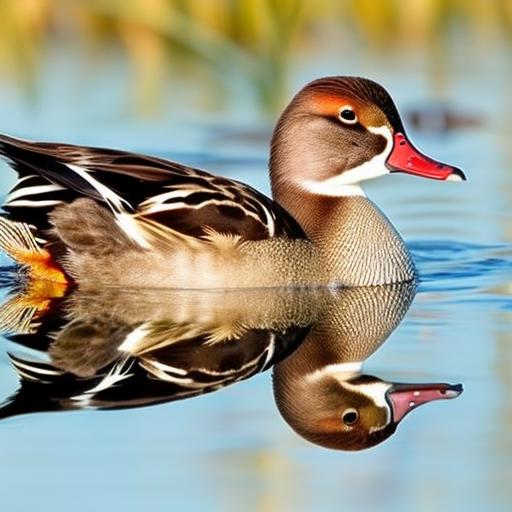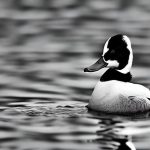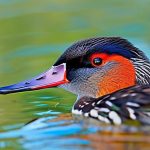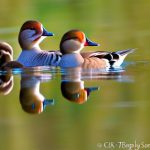Ducks are fascinating creatures that come in a wide variety of breeds, each with its own unique characteristics and uses. From the popular Mallard and Pekin breeds to the rare and endangered Crested and Silver Appleyard breeds, understanding the different types of ducks is important for both enthusiasts and those involved in agriculture and farming. In this article, we will explore the most popular duck breeds, the rare and endangered breeds that need preservation, the differences between domesticated and wild duck breeds, the anatomy of a duck, the colors and patterns of duck breeds, their characteristics and behavior, their importance in agriculture and farming, raising ducks as pets, and capturing their beauty through photography.
Key Takeaways
- Duck breeds come in a wide variety, with different sizes, shapes, colors, and patterns.
- The most popular duck breeds include the Pekin, Muscovy, and Mallard, each with unique characteristics and uses.
- Rare and endangered duck breeds need to be preserved to maintain genetic diversity and prevent extinction.
- Domesticated ducks have been selectively bred for specific traits, while wild ducks have adapted to survive in their natural habitats.
- Understanding the anatomy, colors, patterns, temperament, and behavior of duck breeds is important for farmers, pet owners, and photographers alike.
The Most Popular Duck Breeds
The Mallard is perhaps one of the most well-known duck breeds. It is native to North America and is characterized by its vibrant green head, yellow bill, and brownish-gray body. Mallards are highly adaptable and can be found in a variety of habitats, including ponds, lakes, rivers, and even urban areas. They are also popular among hunters due to their delicious meat.
Another popular breed is the Pekin duck. Originating from China, Pekin ducks are known for their large size and white feathers. They have a calm temperament and are often raised for their meat. Pekin ducks are also excellent egg layers, making them a versatile breed for both meat and egg production.
The Muscovy duck is another popular breed that stands out due to its unique appearance. Unlike other ducks, Muscovy ducks have a red fleshy face called a caruncle. They come in a variety of colors including black, white, chocolate, and blue. Muscovy ducks are known for their lean meat and are often raised for both meat production and pest control due to their appetite for insects.
Rare and Endangered Duck Breeds
While some duck breeds are popular and widely recognized, there are also rare and endangered breeds that need preservation. One such breed is the Crested duck, which is known for its distinctive crest of feathers on its head. Crested ducks come in a variety of colors and are often kept as ornamental birds due to their unique appearance.
The Silver Appleyard duck is another rare breed that is highly sought after for its beauty and versatility. It was developed in the 1930s by Reginald Appleyard and is known for its striking silver and white plumage. Silver Appleyard ducks are excellent egg layers and are also raised for their meat.
Preserving these rare and endangered duck breeds is important to maintain genetic diversity and prevent their extinction. These breeds often have unique characteristics and traits that can be valuable in breeding programs or for those looking to add diversity to their flocks. Additionally, preserving these breeds helps to maintain the cultural heritage associated with them.
Domesticated vs Wild Duck Breeds
There are significant differences between domesticated and wild duck breeds. Domesticated ducks have been selectively bred over generations for specific traits such as meat production, egg-laying ability, or ornamental purposes. They are typically more docile and easier to handle compared to their wild counterparts.
Wild ducks, on the other hand, have not been selectively bred and retain their natural instincts and behaviors. They are adapted to survive in the wild and have a strong sense of flight, making them excellent migratory birds. Wild ducks also have a more varied diet compared to domesticated ducks, as they forage for food in their natural habitats.
Examples of domesticated duck breeds include the Pekin, Muscovy, and Rouen ducks. These breeds have been bred for specific purposes such as meat production or ornamental value. Examples of wild duck breeds include the Mallard, Wood Duck, and Teal ducks.
The Anatomy of a Duck
Understanding the anatomy of a duck is important for both enthusiasts and those involved in duck care and maintenance. Ducks have a unique set of features that allow them to thrive in their natural habitats.
The bill of a duck is one of its most distinctive features. It is designed for foraging and can vary in shape and size depending on the breed. Ducks use their bills to filter food from the water, scoop up insects, and even catch small fish.
Ducks have webbed feet that are adapted for swimming. The webbing between their toes allows them to paddle through the water with ease. This feature also helps them to walk on muddy surfaces without sinking.
Another important feature of ducks is their wings. Ducks have strong wings that enable them to fly long distances during migration. Their wings are also used for courtship displays and territorial defense.
The Colors and Patterns of Duck Breeds
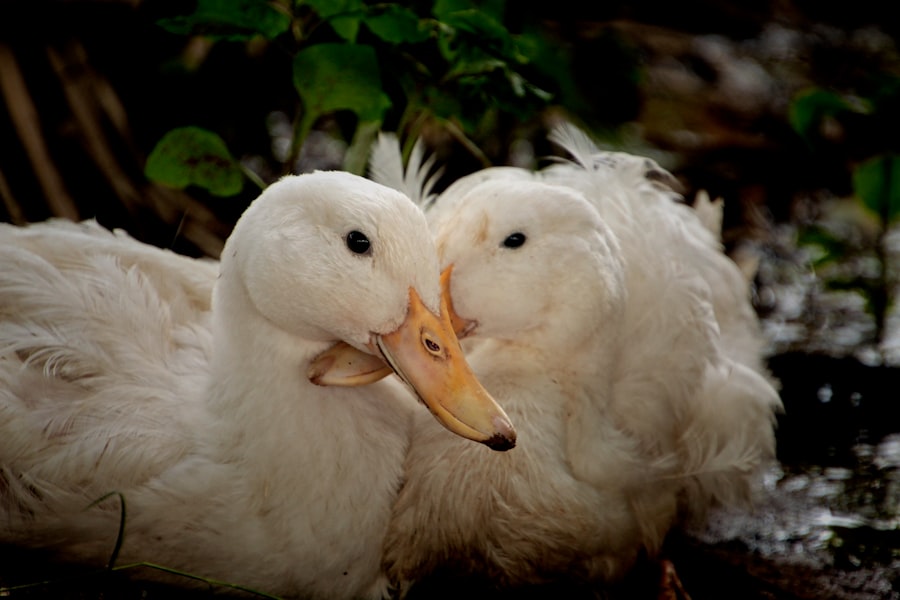
Ducks come in a wide variety of colors and patterns, making them visually stunning creatures. Some breeds have unique colorations that set them apart from others.
The Indian Runner duck is known for its upright stance and slender body. It comes in a variety of colors including white, black, fawn, and chocolate. Indian Runner ducks are popular among enthusiasts due to their unique appearance and active nature.
The Cayuga duck is another breed with striking colors. It has dark feathers that appear black in certain lighting conditions but can have an iridescent green sheen. Cayuga ducks are often kept for their ornamental value and are also good egg layers.
The Characteristics of Duck Breeds
Each duck breed has its own unique characteristics and temperament. Some breeds are known for being friendly and docile, while others may be more independent or aggressive.
The Khaki Campbell duck is a breed known for its friendly and sociable nature. It is highly adaptable and can thrive in a variety of environments. Khaki Campbell ducks are also excellent egg layers, making them a popular choice for those looking to raise ducks for eggs.
The Rouen duck is another breed with distinct characteristics. It is larger in size compared to other duck breeds and has a calm temperament. Rouen ducks are often raised for their meat and are known for their flavorful and tender meat.
The Importance of Duck Breeds in Agriculture and Farming
Ducks play an important role in agriculture and farming. They are versatile animals that can be raised for both meat and egg production, as well as for pest control.
Ducks are excellent foragers and can help control pests such as insects, slugs, and snails. They have a voracious appetite for these pests, making them a natural and eco-friendly solution for pest control on farms.
In terms of meat production, ducks are known for their flavorful and tender meat. They have a higher fat content compared to chicken, which gives their meat a rich and succulent taste. Duck meat is also highly nutritious, being a good source of protein, vitamins, and minerals.
Raising Ducks as Pets
Ducks can also make wonderful pets for those who have the space and resources to care for them properly. When choosing a duck breed as a pet, it is important to consider factors such as space requirements, temperament, and noise level.
Some breeds that are well-suited for pet ducks include the Pekin, Khaki Campbell, and Indian Runner ducks. These breeds are known for their friendly nature and adaptability to different environments.
Caring for pet ducks involves providing them with a suitable living environment, proper nutrition, and regular veterinary care. Ducks require access to water for swimming and bathing, as well as a secure enclosure to protect them from predators.
Capturing the Beauty of Duck Breeds
Ducks are beautiful creatures that can be captured through photography. Whether you are a professional photographer or simply enjoy taking pictures, there are several tips that can help you capture the beauty of duck breeds.
One important tip is to get down to the duck’s eye level. This allows you to capture their unique perspective and creates a more intimate connection with the subject.
Another tip is to pay attention to lighting. Ducks can have iridescent feathers that reflect light in different ways. Experimenting with different lighting conditions can help you capture the colors and patterns of their plumage.
Understanding the different duck breeds is important for both enthusiasts and those involved in agriculture and farming. From the popular Mallard and Pekin breeds to the rare and endangered Crested and Silver Appleyard breeds, each breed has its own unique characteristics and uses. Whether you are interested in raising ducks for meat and eggs, preserving rare breeds, or simply appreciating their beauty, there is much to learn about these fascinating creatures. So take the time to explore the world of duck breeds and discover the wonders they have to offer.
If you’re interested in learning more about different duck breeds, you might also enjoy reading an article on Poultry Wizard that discusses the various types of ducks and their unique characteristics. From the adorable and popular Pekin ducks to the striking and colorful Indian Runner ducks, this article provides a comprehensive overview of different duck breeds. Check it out here to discover more about these fascinating feathered friends.
FAQs
What are duck breeds?
Duck breeds refer to the different types of ducks that exist, each with unique physical and behavioral characteristics.
How many duck breeds are there?
There are over 100 different duck breeds recognized worldwide.
What are some common duck breeds?
Some common duck breeds include the Pekin, Mallard, Muscovy, Rouen, and Khaki Campbell.
What are the differences between duck breeds?
Duck breeds differ in size, color, feather patterns, behavior, and egg-laying abilities.
What are some uses for duck breeds?
Duck breeds are used for meat, eggs, feathers, and as pets or for ornamental purposes.
What are some interesting facts about duck breeds?
Ducks have waterproof feathers, can fly up to 60 miles per hour, and have a unique gland that produces oil to keep their feathers waterproof. Some duck breeds, like the Muscovy, are known for their ability to control pests like mosquitoes and flies.
Meet Walter, the feathered-friend fanatic of Florida! Nestled in the sunshine state, Walter struts through life with his feathered companions, clucking his way to happiness. With a coop that’s fancier than a five-star hotel, he’s the Don Juan of the chicken world. When he’s not teaching his hens to do the cha-cha, you’ll find him in a heated debate with his prized rooster, Sir Clucks-a-Lot. Walter’s poultry passion is no yolk; he’s the sunny-side-up guy you never knew you needed in your flock of friends!

